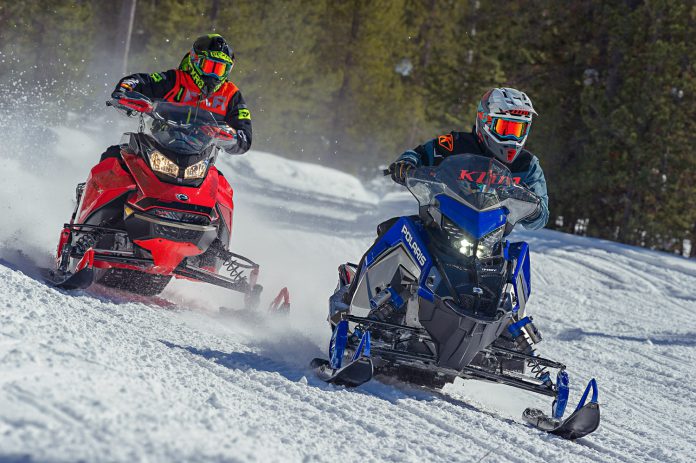Thought I might try and answer, from personal experience and observation, a burning question that appears to be weighing heavily on the minds of our loyal followers. The question? How long should a 2-stroke snowmobile last?
Before I delve into this complex question and gift you with one of my highly-informed diatribes, I need to make one caveat clear. The word “last” is a little ominous when discussing anything related to snowmobiles. For our purposes I will suggest “last” really means: “before significant jing needs to be spent”.
If we’re talking the two most popular segments in the sno-mo-2-stroke market, the 600 and 800 class, we’ll jump into the 600 class first. A current garden variety 600 twin engine in the popular trail/sport category can deliver up to 12,000 miles (19,000 kms) of reasonable use.
Reasonable use includes using good quality injector oil, regular servicing of the exhaust valves and annual clutch maintenance. Clutch maintenance, although not specifically engine maintenance, can affect the performance and longevity of a 2-stroke mill.
Are there exceptions to this mileage threshold? For sure! In fact, I’ve seen lots of 600 2-strokes with more miles than I’ve posited. For the record, I’ve seen less.
Do 800’s live longer or shorter than 600’s? Here are some issues: There have been some 800 class engines that live considerably longer than others. Take Arctic Cat’s 800 EFI Suzuki, laydown, backwards twin from a few years back. This engine is virtually indestructible – with few exceptions. Suzuki has a stellar rep for building long lasting, durable engines – both 2 and 4-stroke. If you can stand the smoking these anvils are known for, you can get huge miles out of one. How many miles? Maybe 15,000 (24,000 km) or more.
At the other end of the spectrum is Ski-Doo’s Series III 800 2-stroke used through the 2016 model year. These engines were notorious for kicking cranks out when the PTO (left side) bearings’ sealed Isoflex lubrication dried out or leaked out.
I’ve commented on these engines usable life spans many times in Supertrax Magazine. When one of these motors gets to 6,000 miles or 10,000 klicks you must re-lubricate or replace the PTO side crank bearings. To do this in a meaningful way most often requires major engine disassembly. If you don’t do this necessary work, you’re playing a game of sno-mo crankshaft roulette.
Do snowmobile 2-strokes need to have rings and pistons replaced every 10,000 miles? Not necessarily. A thorough look-see at the motor through the exhaust port and a standard compression test not to mention your seat-of-pants evaluation of power, acceleration and piston slap (rattle) will expose a wealth of information.
Keep in mind that the mileage thresholds I’ve mentioned here are also good for evaluating chassis wear. Any sled with more than 10,000 miles on the odometer should have the drive axle, jackshaft and chaincase bearings examined carefully. Replacing them at the 16,000 klick mark (IMO) is good preventative maintenance.
While performing this kind of chassis service at these mileage levels, take a look at the skidframe tires and bearings. Tires are prone to blow out from bearing failure once you pass the 10K mileage level. Trust me – it’ll almost always happen on a WOT run down Kevlar Lake.
No doubt I’ll receive lots of disagreeing hate mail from this brief and highly generalized article. Fine. However, there really is no magic number for how long a 2-stroke will last. What is for sure is this: You will, without any doubt, enjoy longer, trouble-free service from your 2-stroke if you look after it.








